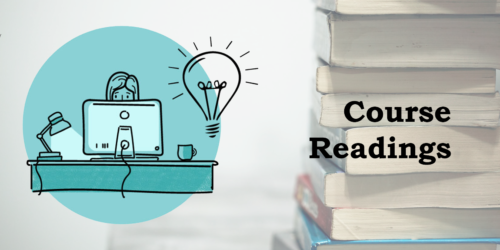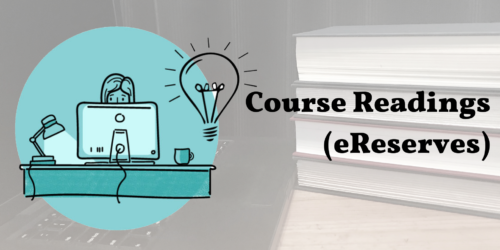
Active and Problem-Based Learning Resources
Whether teaching virtually, in person, or any combination of the two, faculty are often looking for ways to keep students engaged during class. Active learning and problem-based learning (PBL) approaches provide students with meaningful and memorable pedagogical experiences that encourage them to be the drivers of their own learning and to relate what is discussed in class to the outside world.
In partnership with Library Services, we’ve assembled and annotated a list of helpful library resources for faculty looking for fresh ideas for the classroom. The list is broken down into academic journals, books, and specific articles on the topic.
Notes are provided to highlight resources that are practical vs theoretical, discipline-specific, and cater to faculty who are either new to PBL and active learning or seasoned aficionados. Many of these resources also represent global research projects, so may be of particular interest to faculty members seeking innovative ways to engage international students.
When reading through the lists below, please note that clicking on the permalink associated with each reference will lead you directly to the source in the Conestoga library.
Academic Journals
Interdisciplinary Journal of Problem Based Learning
Interdisciplinary Journal of Problem-Based Learning. Purdue University. ISSN 1541-5015. https://scholarworks.iu.edu/journals/index.php/ijpbl
Offers program-specific PBL strategies and reflections from the perspective of faculty and students (including K-12 and post secondary). Likely to be most relevant for educators searching for specific strategies and techniques within their own teaching areas (wide range of program specific articles –though weighted heavily towards STEM subjects).
International Journal of Teaching in Higher Education
International Journal of Teaching and Learning in Higher Education. International Society for Exploring Teaching and Learning. ISSN 1812-9129. https://www.isetl.org/ijtlhe/ijtlhe-article-collections.php?c=1#articles
Primary focus is improving teaching at the post secondary level. Journal’s focus is not specifically PBL, but many articles do touch on meaningful and interesting approaches to collaborative work. A number of topics are discipline-specific ( helpful and easily searchable for faculty members working in these fields), but other approaches could apply to many different classes (i.e., the 2020 issue has an article about how one could incorporate “physical activity” into the college classroom in general).
Journal of Problem Based Learning
Journal of Problem Based Learning. University of Malaya. ISSN: 2288-8675, 2508-9145. https://www.ejpbl.org/about/index.php
Resource for faculty seeking specific interdisciplinary and evidence-based examples of PBL approaches. Certain disciplines seem to be represented more than others (there are a great many articles about engineering, nursing, health and dentistry, for example), but one of the strengths of the journal is that it is international in scope and this research could be of help to all faculty seeking to improve intercultural communication and find new strategies for engaging international students specifically. There are also several articles that serve as a good introduction to PBL for faculty members who are new to this approach.
Journal of Problem Based Learning in Higher Education
Journal of Problem Based Learning in Higher Education. University of Aalborg. ISSN 2246-0918 https://journals.aau.dk/index.php/pbl/about
Journal covers a broad range of topics related to PBL including associated principles and pedagogies, its usefulness in workplace cultures, benefits to using PBL strategies in intercultural studies, and links between PBL and technology enhanced learning. Several articles speak to case studies from around the globe, while others focus more on general PBL principles. The journal appears to have launched in 2017, and so articles and archives are limited, but amongst them are discipline and theme-focused special issues.
Educational Sciences
Vaz de Carvalho, C., & Bauters, M. (2022) Special Issue “Emergent Technologies to Support Active Learning in Higher Education”. Education Sciences. MDPI AG. ISSN 2227-7102. https://www.mdpi.com/journal/education/special_issues/_HighEducation_Technologgies *Upcoming 2022 Special Issue* (Has not been published yet)
Books
A Guide to Teaching in the Active Learning Classroom
Baepler, P., Walker, J. D., Brooks, D. C., Saichaie, K., & Petersen, C. I. (2016). A Guide to Teaching in the Active Learning Classroom : History, Research, and Practice: Vol. First edition. Stylus Publishing. http://ra.ocls.ca/ra/login.aspx?inst=conestoga&url=https://search-ebscohost-com.conestoga.idm.oclc.org/login.aspx?direct=true&db=nlebk&AN=1898936&site=eds-live&scope=site
This book offers a solid introduction to Active Learning Classrooms (ALCs) It will likely be most helpful for faculty members (from any discipline) who are looking to move away from traditional ways of teaching where the instructor is the central focus of the classroom. The book provides a general history of AL (answering “why” education is moving in this direction), and offers practical tips on subjects such as classroom management, appropriate types of assignments and other assessments, and common challenges in AL classrooms.
Interactional Research into Problem Based Learning
Bridges, S., & Imafuku, R. (2020). Interactional Research Into Problem-Based Learning. Purdue University Press. http://ra.ocls.ca/ra/login.aspx?inst=conestoga&url=https://search.ebscohost.com/login.aspx?direct=true&db=nlebk&AN=2519567&site=eds-live&scope=site
Though accessibly written, this book will likely be most useful for faculty who already have some experience designing and delivering PBL in their classrooms. This book moves away from focusing simply on knowledge-based outcomes and focuses instead on student experiences. Though the case studies presented come from specific classrooms in various regions around the world, the “take-aways” are broad enough that they are likely to be of interest to faculty members from any discipline. Some themes include: student perspectives on how collaborative learning happens; dominance vs quietness in group dynamics; managing mobile phone use in the classroom etc.
Best Practices in Engaging Online Learners Through Active and Experiential Learning Strategies
Budhai, S.S., & Skipwith, K.B. (2021). Best Practices in Engaging Online Learners Through Active and Experiential Learning Strategies (2nd ed.). Routledge http://ra.ocls.ca/ra/login.aspx?inst=conestoga&url=https://www.taylorfrancis.com/books/9781003140405
This book may be especially helpful for faculty members teaching asynchronous or hybrid courses. While not all chapters speak to PBL directly, there are several helpful and practical examples included (Chapter 3 specifically). The book offers numerous strategies for instructors to keep students engaged in virtual formats with an eye to how this learning can also be expanded to include real-world field-based experiences and other connections. Chapter 6 also offers some practical techniques for assessing experiential learning online.
How to Guide for Active Learning
Fornari, A., & Poznanski, A. (Eds.). (2021). How-to Guide for Active Learning. Springer International Publishing AG. https://ebookcentral-proquest-com.conestoga.idm.oclc.org/lib/conestogac/detail.action?docID=6628954.
This book reads essentially as a “how to” guide for faculty members interested in incorporating more active learning practices in their classrooms. The book opens with an overview and rationale for active learning, and then each of the subsequent chapters offer AL tools and strategies to help spark critical thinking and other learning objectives. Chapter 9 is most closely aligned with PBL principles, but several other chapters also offer active learning activities that encourage collaboration and communication.
Learning Innovation and the Future of Higher Education
Kim, J. & Maloney, E. (2020). Learning Innovation and the Future of Higher Education. Johns Hopkins University Press. http://ra.ocls.ca/ra/login.aspx?inst=conestoga&url=https://search.ebscohost.com/login.aspx?direct=true&db=nlebk&AN=2266285&site=eds-live&scope=site
This book focuses specifically on digital learning and provides several different theories and methodologies about why technology is changing and how it ought to be taught moving forward. Aspects of this book relate directly to active learning and PBL, but it will likely be of interest primarily to faculty who have extensive experience teaching about digital learning as it is more theoretical than practical.
The Professor’s Guide to Integrating Writing, Critical Thinking, and Active Learning in the Classroom
Melzer, D, and Bean, J.C. (2022) Engaging Ideas : The Professor’s Guide to Integrating Writing, Critical Thinking, and Active Learning in the Classroom, John Wiley & Sons. https://ebookcentral-proquest-com.conestoga.idm.oclc.org/lib/conestogac/detail.action?docID=6632622Misseyanni,
This easy-to-read book focuses primarily on active learning strategies that can help students improve writing and critical thinking skills. It offers step-by-step guides for designing assessments and in-class activities. The book also offers practical advice to faculty who may be overwhelmed by grading and offers active learning activities that allow students to assess their own and peers’ work before submitting final projects/papers.
Active Learning Strategies in Higher Education
Misseyanni, A.; Lytras, M.D.; Papadopoulou, P. & Marouli, C. (2018). Active Learning Strategies in Higher Education : Teaching for Leadership, Innovation, and Creativity: Vol. First edition. Emerald Publishing Limited.A., http://ra.ocls.ca/ra/login.aspx?inst=conestoga&url=https://search.ebscohost.com/login.aspx?direct=true&db=nlebk&AN=1624263&site=eds-live&scope=site
This book focuses on 21st century learning skills—innovation and creativity especially. Chapters are written by experienced instructors teaching in various disciplines around the world, taking into account the importance of student-centred learning and interdisciplinarity in teaching and learning today. Different chapters explore how Information Communication Technologies and active and experiential learning can improve student performance in the classroom and also help transform learners into more aware and engaged citizens. Faculty may find it helpful to read one or two chapters most relevant to their own teaching—the book does not need to be read in its entirety.
Teaching as the art of Staging
Weston, A. (2019). Teaching As the Art of Staging : A Scenario-Based College Pedagogy in Action: Vol. First edition. Stylus Publishing. http://ra.ocls.ca/ra/login.aspx?inst=conestoga&url=https://search.ebscohost.com/login.aspx?direct=true&db=nlebk&AN=1991707&site=eds-live&scope=site
This playful book suggests that educators need not be the traditional “sage on the stage” in the classroom, nor aspire to be the “guide on the side” who lets students lead the way. Instead, Weston believes a third way forward might be most appropriate: “the Impresario with a Scenario, a teacher who serves as class mobilizer, improviser, and energizer, staging dramatic, often unexpected and self-unfolding learning challenges and adventures with students.” Weston draws on his own experiences “staging” a classroom to argue that teaching can be both “teacher centred” and “student centred” at the same time—and “active” for both parties.
Journal Articles
Assessing Evaluation
Alonso-Nuez, M. J., Gil-Lacruz, A. I., & Rosell-Martínez, J. (2021). Assessing evaluation: why student engages or resists to active learning? International Journal of Technology & Design Education, 31(5), 1001–1017.
http://ra.ocls.ca/ra/login.aspx?inst=conestoga&url=https://search-ebscohost-com.conestoga.idm.oclc.org/login.aspx?direct=true&db=edb&AN=152853853&site=eds-live&scope=site
This article presents data collected from close to 5000 engineering and design students to show a strong correlation between active learning and increased student engagement. It highlights especially the role that faculty can play in encouraging active learning amongst students who may be resistant. This research presents a very specific approach to PBL (rather than a general, more accessible overview) that some faculty may find helpful.
Pedagogical Innovation in Higher Education and Active Learning Methodologies
Carvalho, A., Teixeira, S. J., Olim, L., Campanella, S. de, & Costa, T. (2021). Pedagogical innovation in higher education and active learning methodologies – a case study. Education + Training, 63(2), 195–213. http://ra.ocls.ca/ra/login.aspx?inst=conestoga&url=https://search-ebscohost-com.conestoga.idm.oclc.org/login.aspx?direct=true&db=edb&AN=148339732&site=eds-live&scope=site
This article reflects qualitative research conducted at the Higher Institute of Administration and Languages, exploring student and teacher perspectives of active learning methodologies. The manuscript is a rather dense read but may be of interest to those seeking to better understand why/how certain active learning pedagogical practices can be challenging to implement.
Active Methodologies in Higher Education
Crisol-Moya, E., & Romero-Lopez, M. A. (2020). Active Methodologies in Higher Education: Perception and Opinion as Evaluated by Professors and Their Students in the Teaching-Learning Process. Frontiers in Psychology. http://ra.ocls.ca/ra/login.aspx?inst=conestoga&url=https://search.ebscohost.com/login.aspx?direct=true&db=edsdoj&AN=edsdoj.1a03e2765733402ba4611d1a4f29860e&site=eds-live&scope=site
This article traces the shift away from teacher-centred learning towards more student-centred, constructivist learning in Spain. The research presented is based on the experiences of teachers and students in 5 different disciplines (Arts and Humanities, Sciences, Health Sciences, Social Science and Engineering and Architecture). This paper does not provide many specific examples of active learning techniques, but it does offer up an interesting discussion about how students/ teachers define “active learning” and their differing perceptions on its effectiveness. This is likely to be of interest to faculty seeking a deeper understanding about active learning theory and its implementation on a global level.
Instructor Strategies to aid Implementation of Active Learning
Nguyen, K., Borrego, M., Finelli, C., DeMonbrun, M., Crockett, C., Tharayil, S., Shekhar, P., Waters, C., & Rosenberg R. (2021). Instructor strategies to aid implementation of active learning: a systematic literature review. International Journal of STEM Education, 8(1), 1–18. http://ra.ocls.ca/ra/login.aspx?inst=conestoga&url=https://search.ebscohost.com/login.aspx?direct=true&db=edsdoj&AN=edsdoj.3a45244c832a4334891e20f53df262f4&site=eds-live&scope=site
This article may be particularly interesting to faculty teaching Science, Technology, Engineering, and Math (STEM) courses. It explores the slower adoption of active learning and perceived student resistance in these fields. This article offers several specific examples of active learning strategies that students and teachers found rewarding (even in traditional lecture-based classes). The article concludes by providing advice to faculty in these disciplines—especially with regards to how they may go about explaining the importance of active learning to students prior to engaging in certain activities, so that they are assured these new approaches to learning connect with overall course outcomes.
Evaluation of Four Digital Tools and Their Perceived Impact on Active Learning, Repetition and Feedback in a Large University Class
Tautz, D., Sprenger, D. A., & Schwaninger, A. (2021). Evaluation of four digital tools and their perceived impact on active learning, repetition and feedback in a large university class. Computers & Education, 175 http://ra.ocls.ca/ra/login.aspx?inst=conestoga&url=https://search-ebscohost com.conestoga.idm.oclc.org/login.aspx?direct=true&db=edselp&AN=S0360131521002153&site=eds-live&scope=site
This article takes an in depth look at if and how several different digital tools can enhance active learning in a large university classroom. This research is likely to be of interest to faculty eager to incorporate digital leaning tools into their teaching and/or for those teaching remote or hybrid courses. Of particular note: this study showed that some tools (like Virtual Reality) that initially appeared exciting to students ended up being rated by them to have a lower impact on their learning than more standard tools (like recorded lectures).
There are a great many active and problem based learning activities that can be easily incorporated into any classroom setting. The resources listed above offer detailed descriptions of when and how specific activities have been carried out in other classrooms around the world and also describe the importance of these strategies for students and faculty alike. For additional active learning ideas compiled by our Teaching and Learning consultants, please check out this faculty hub post .






